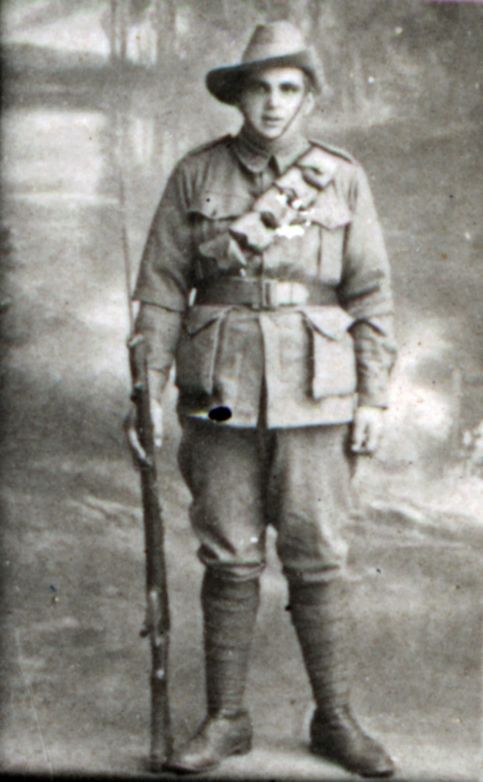The Road to Peronne
contributed by Michael Hall
|
At the rear of the National Sports Club in Lyneham is a vacant block of ground strewn with old bricks and stones and scraggly hawthorn bushes. This is the site of Hawthorn Cottage, the home of Mary McDonald. Twice widowed and childless she devoted her considerable energy to her church and fostering children. One of her children was George Potter.
George and his brother and sister grew up at Hawthorn Cottage. He stayed there running the farm until Mrs. McDonald died in early 1915 and after settling her estate he enlisted at 23 years of age. George joined the 53rd Battalion in France at the end of July 1916 and participated in the 5th Divisions’ campaigns at Flers during the winter of 1916-17, on the Bapaume-Cambrai road in March 1917, at the Second Battle of Bullecourt in May 1917 and Passchendaele in October 1917 and was appointed as a Lance Sergeant in December 1917 before receiving a bullet wound at Villers-Bretonneux the following April. At almost six feet (180cm) tall and weighing nearly 15 stone (93kg) he was bigger than most men of his generation, ungainly with a “thin, wheezy voice”. Life had been tough but George could roll with the punches. While on his way to a farewell party in March 1916 the buggy he was travelling in tipped over at Ginns Gap (where the Federal Highway crosses Majura Road). He survived the crash and seemed set to survive the Western Front, though for a while bullets and shells seemed to follow him around and he told his mates they may as well pack up and go home. “I seem to be fighting this bloody war on my own” he said. “I will write and tell you the result”. By late August 1918 the 2nd and 5th Divisions of the AIF were pressing the Germans as they retreated towards Péronne, a walled town protected by the Somme and Cologne rivers and at its rear, Mont St. Quentin. The 2nd Division assaulted the Mont; the following day, on 1 September, the 5th Division was to attack Péronne with its 53rd and 54th Battalions. As they advanced past Park Wood, Potter’s company was faced by German machine guns firing from behind several unbroken belts of wire and a barrage of shells. The only way through the wire was a gap where the road to Péronne passed through. “Men died like flies there and we faltered”, wrote his Company Sergeant Major, Clarrie Burns, “but old George Potter firing burst after burst from the Lewis gun at his hip silenced a nest of German machine-guns and enabled us to stream through the narrow inlet”. His bravery came at the ultimate price as he attracted the fire of the enemy. “Machine-gun bullets had torn his body almost in holes”, said Burns, “but they could not wipe the grin from his face nor wrest the finger from the trigger of his beloved gun”. The attack was a success and the 5th Division entered Péronne. Burns, who was awarded the Distinguished Conduct Medal for his own actions that day, recalled in 1938 that “every Anzac Day a section of the old 53rd Battalion, by common consent, drink a silent toast to the memory of George Potter. We feel like pooling the decorations issued to us and casting them aside, for this truly great man received but a wooden cross for the part he played in laying down his life for his country and the saving of his friends”. |
 |

